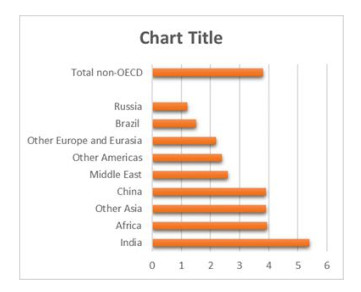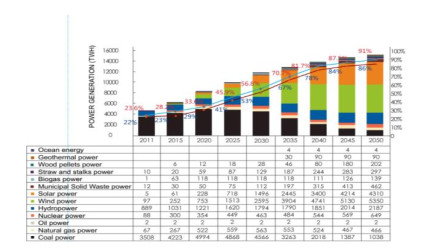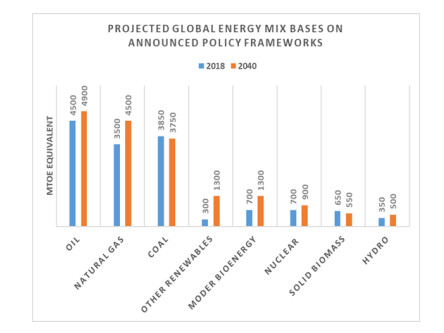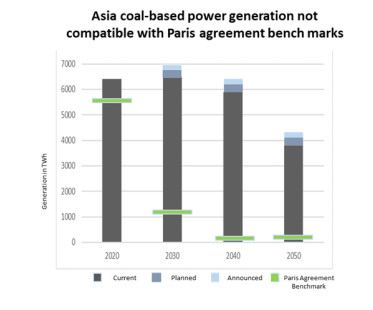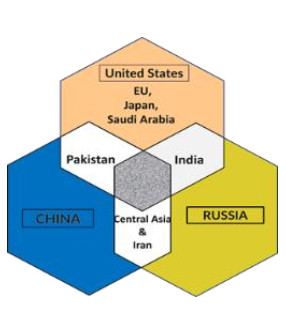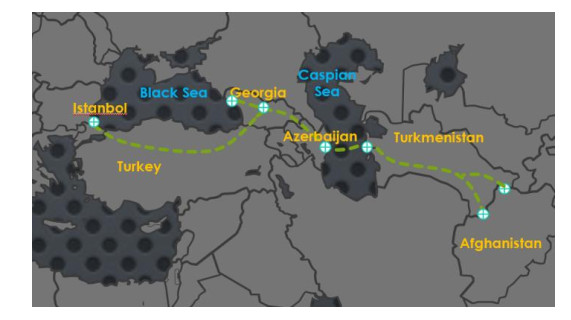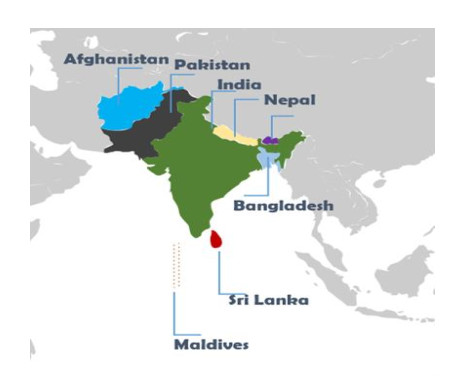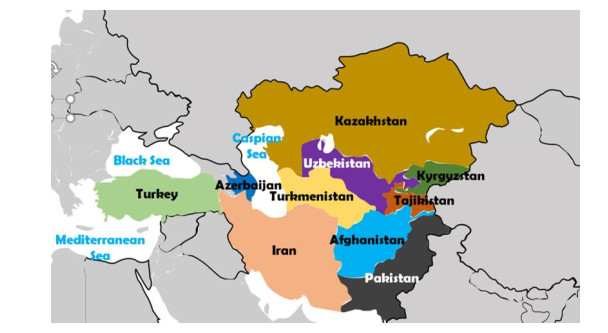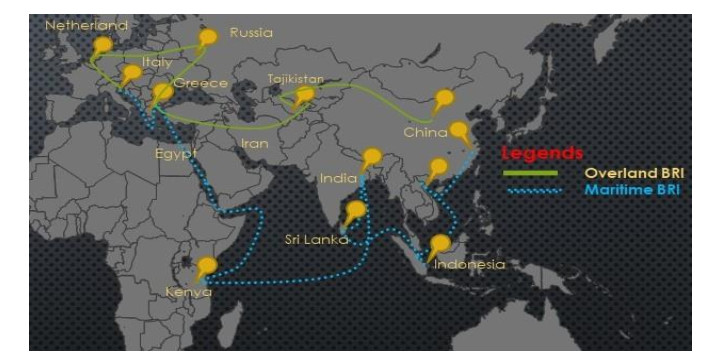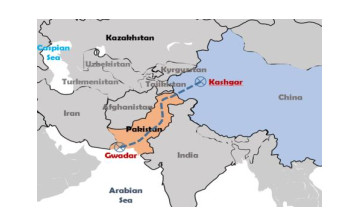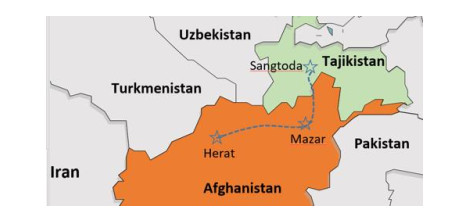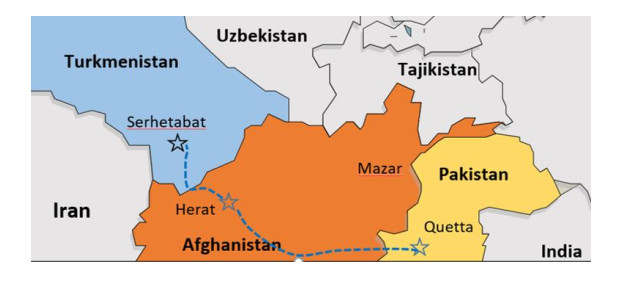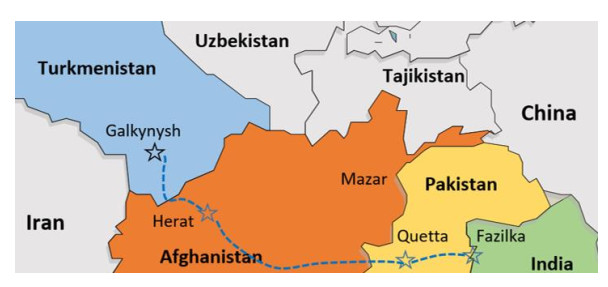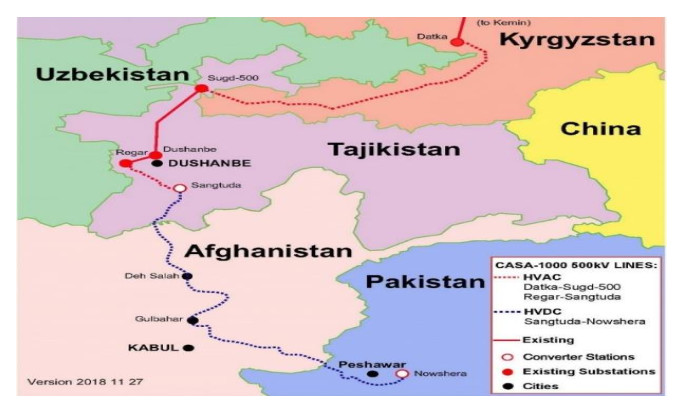Abbreviations: ADB: Asian Development Bank; BP: British Petroleum; BRI: Belt and Road Initiative; BTU: British Thermal Unit; GHG: Greenhouse Gas; IEA: International Energy Agency; IRENA: International Renewable Energy Agency; Mtoe: Million Tonnes of Oil Equivalent; TWH: Terawatt-Hour; WB: World Bank; WEO: World Energy Outlook
1.
Introduction
Energy is a strategic commodity for all industrial countries, and most of the energy consumption will be in the form of electricity in a couple of decades. Regional transmission lines and power trade are always a good option. They would help the region to use each other's surplus power and enhance efficiency at the regional level, as well as help to mitigate climate change due to excessive fossil fuel energy consumption. Therefore, electricity trade will remain a non-exhausting business for the region. However, fossil fuel trade may be contingent on the technology development, renewable energy integration and price, global restrictions on fossil fuel consumption, coal retirement plans at the global level, oil and gas retirement, nuclear energy takeover and advancement and any other technology breakthrough in the coming decades, and it will affect the investment decisions of the major investors.
Asia, especially China and India, will soon become the world's major economies and consumers of energy resources [1]. This continent also hosts major oil and gas producers and exporters. Russia, Turkmenistan, Iran and Kazakhstan, including middle-east oil and gas-rich countries, are among the major ones [2].
Some academics and practitioners in Regional Economic Cooperation Conference of Afghanistan (RECCA) identified that energy cooperation is essential for the region's economic integration, especially in South Asia and Central Asia. Increasing efforts for the completion of major regional economic cooperation projects and supporting on-going Afghanistan-centered regional energy projects such as TAPI, CASA-1000 and TAP-500 (See Appendix for more details about regional energy initiatives), can lay the foundation for a new regional energy market and trade era for the benefit of the countries in Central, South and Southwest Asia and beyond [3]. The regional energy networks (power super-grid, gas and oil) would allow many countries to invest and benefit.
Most of the countries in Asia are somehow interdependent on their neighbors or the regional countries. If one needs energy, the other might need to traverse the other for the transit of its commodity, access the sea or make its way to the energy-fertile land. In the Afghanistan and Pakistan cases, the former needs to connect to China, South Asian Association for Regional Cooperation (SAARC) countries and the sea through Pakistan. The latter needs Afghanistan to connect to the central and Eurasian regions [4]. As a potential emerging energy hub, Afghanistan can play a pivotal role in the consumption and transit of Central Asian energy to south Asia. However, regional agreements on multiple conflicting and controversial issues need to be reached [5].
Although there are existing sea and land routes for energy transportation to major consumers, the shortest routes through Afghanistan have never been utilized due to security hurdles. Afghanistan is the most economical and inimitable terrestrial corridor for the regional energy trade and transit upon which all stakeholders can agree. This corridor could also save billions of dollars a year in data movement between Europe and Asia compared to the current routes. In addition to regional benefits, it opens up the international markets' doors to the billions of dollars' worth of Afghanistan's untapped mineral resources [4]. The security issues in Afghanistan not only affected energy trade in the region, but they also escalated regional and international rivalries, reduced regional land transportation and exported extremism and instability to the regional countries.
Many pieces of literature identify that all regional mega projects have numerous risks. However, the establishment of policies and institutional arrangements would help these risks to be mitigated, and the full potential of the regional trade and investment could be realized [6].
This paper discusses major barriers and opportunities related to the region's energy trade, as well as the importance of the Afghanistan factor. It provides an image of the future regional energy trade and connectivity. It also provides recommendations for major regional and global powers and stakeholders on how Afghanistan can play a positive role in economic development and the sustainability of the region and the globe. It also warns about the negative role Afghanistan could play if the political and security status quo does not improve.
2.
Literature review
From a technical perspective, a region's energy demand and supply potentials in the medium and long term establishes the bedrock for any cross-border energy trade initiatives and discourse. For any further discussion on energy trade, it is necessary to know the supply and demand potential in the region. Furthermore, the political and economic conditions in a region is another key factor in shaping energy trade in that region. This section summarizes the energy reserves, current and future patterns of the potential consumption and demand in the region and political and the economic aspects in the region in which Afghanistan is located.
2.1. Energy reserves and consumption in the region
There is nearly 1,730 billion barrels of proven oil reserves (equivalent to 244 billion tons of oil), 7,000 trillion cubic feet of natural gas (equivalent to 170 trillion cubic meters) and 1055 billion tons of proven coal reserves around the globe. With the current annual production rate (nearly 35 billion barrels of oil, 3.8 trillion cubic meters of natural gas, 4 billion tons of coal per year), the oil reserves will be enough for another 50 years, natural gas for another 51 years and coal for around 250 years.
The world's primary energy consumption in 2018 reached around 14,000 million tonnes of oil equivalent (Mtoe). From around 26,600 terawatt-hours of electricity generated in 2018, the share of coal, natural gas, hydropower, nuclear energy, renewable energy and oil were around 10,000, 6,200, 4,200, 2,700, 2500 and 800 terawatt-hours, respectively. Approximately 60% of the electricity generated in the Asia Pacific region is from coal, 12% from natural gas, 12% from hydropower resources and 9% from renewable energies; the remaining is from oil and nuclear energy. From nearly 33 billion tons of CO2 emitted in 2018 around the globe, 50% are associated with the Asia Pacific region, 18% with North America and 12% with Europe. China, the USA and India are ranked 1st, 2nd and 3rd for owning 27.8%, 15.2% and 7.3% of the world's total CO2 emissions [2] respectively.
The 7.6 billion population of the world is expected to reach 8.6 billion by 2030 and 9.8 billion by 2050; 5.3 billion of this population will be living in Asia. India and China shares would be 1.64 and 1.4 billion, respectively [7]. Table 1 shows the population growth of Afghanistan and its regional countries by 2050. Moreover, Asian countries are rich in fossil fuel resources. The fossil fuel reserves of Afghanistan and its regional countries are summarized in Table 2.
2.2. Current and projected energy mix of the regional countries for 2050
According to the US Energy Information Administration (EIA) report, International Energy Outlook 2019, the largest economic growth by 2050 is predicted for non-Organisation for Economic Co-operation and Development (OECD) countries, with India at the top as the reference case. (The reference case reflects current trends and relationships among supply, demand and prices in the future.)
Figure 1 presents an average annual percent change in gross domestic product (GDP) between 2018 and 2050 [11]. World energy consumption will rise by nearly 50% between 2018 and 2050. Energy consumption in non-OECD countries will increase by nearly 70%, in contrast to a 15% increase in OECD countries [11], with India and China at the top. Most of the energy in non-OECD countries will be consumed by industries using electricity [11].
By 2050, almost 50% of the world's electricity generation will come from renewable energy. Although more than 50% of India's electricity demand is expected to be met by renewable energy by 2050, it will remain the world's largest coal importer. World petroleum and other liquid fuel consumption nearly double in non-OECD regions in the reference case. Transportation remains the largest consumer of liquid fuels. It is projected that Asian natural gas consumption will grow faster than its production [11]. Table 3 describes the fossil energy demand of major consumer countries in the region.
As the electrification rate goes higher, it will help renewable energy to grow faster. For example, by 2050, 60% of China's end-use energy will be in the form of electricity. Its renewable energy policy is developed for the realization of this vision. This policy is focused on its economic growth trends and ambitions, national energy supply security concerns, air pollution prevention and control plans, integration and promotion of non-coal and non-fossil fuel energy sources, expansion of EV technologies and usage, utilization of solar water heating and domestic renewable energy (wind and PV) [13]. Under the high penetration scenario of renewable energy (Figure 2), China's 60% of primary energy demand could be met by the renewable energy resources, constituting 86% of the total electricity generation, which will drop the share of coal in electricity generation to 7% [14].
India's total primary energy supply will almost double by 2030. With the largest and most ambitious renewable energy plan globally, India could have a leading role in renewable energy transformation in the region and the world [15]. Although India's ambitious plan for renewable energy integration would reduce its reliance on fossil fuel, it would still need to purchase power from its neighboring countries, if available at a competitive price. The existing energy mix and key energy indicators of the regional countries are described in Table 4.
Although there are massive resources of coal and peat available worldwide, future legal, environmental, economic and social constraints will limit its recovery significantly. Competition between renewable and clean energy resources and public choices will be key determinants of coal utilization in the future [20]. According to the International Energy Agency (IEA) and World Energy Outlook 2019, the global energy mix for 2040 is predicted to change significantly (Figure 3).
Considering the Paris climate change commitments and other economic and social issues, some of the world's largest asset managers and owners in Japan, China, South Korea, Singapore and the Philippines, as well as some other economies in the region, declared their plans for phasing out coal mining and coal-fired power plants [21]. But, regretfully, according to the Climate Analytics 2019 report, the coal-based power generation plans in all Asian countries are way beyond the benchmarks set in the Paris Agreement and constitute a great source of concern for the world climate and environment protection (Figure 4) [22,23].
2.3. Key conflicts and challenges in regional energy trade
The mother of all major security and political problems in the region is the rivalries of the four major powers, i.e., the USA, China, Russia and India. However, the political issues between neighboring countries have added to its complexity. At least three main political alliances are actively engaged in regional politics, which are directly linked to many security and economic activities and issues in the region, including energy trade. The USA, China and Russia lead these allies. The diagram in Figure 5 depicts these linkages.
Some key conflicts between regional and global powers affecting the energy trade and connectivity in the region are further described here.
Since 1949, USA-China relations have experienced numerous diplomatic tensions and standoffs, escalated international rivalries and increased interlinked economies [25]. Nevertheless, they have some common traits from the energy perspective, like being major producers and consumers of coal, top importers of oil and greenhouse gas emissions. Shaffer, in her book, Energy Politics, discusses that China and the USA are colliding in some instances and in coalition in some others. They both compete to have access to oil supply resources. China challenges USA policies in the Middle East and competes with USA allies (India, Japan and South Korea) in Asia. However, they both are interested in low and stable oil prices, a stable Middle East and safe sea routes for energy product transit [1].
USA-Russia major conflicts are in the areas of arms control, the Eastern Mediterranean region and the Arctic [26]. However, after the 9/11 attack, especially after the Iraq War, Moscow and Washington's relations have been the worst since the Cold War. Since then, Russia has shown aggressive behavior toward the USA [27].
The trend of energy demand, consumption and imports has been very analogous for India and China. Both import and compete for the resources of the same regions, the Middle East and North Africa. Their competition has negatively resulted in both and led them to enter into a bidding war with each other, resulting in the escalation of energy procurement cost. However, recently, China and India formed a joint group to avoid competition, find ways of cooperation, increase their bargaining power and negotiate better prices with OPEC [28]. On the regional level, China and India are still competing in the region and investing in the regional economic corridor, the China-Pakistan Economic Corridor (CPEC) and Chabahar, respectively. Also, agreements on a couple of transport infrastructure projects, i.e., Lapis-Lazuli and the Five Nations Railway Corridor (connecting China, Kyrgyzstan, Tajikistan, Afghanistan and Iran), have been recently signed (Figure 6) [29].
Alhasan argues that India has not been so successful in China and India's rivalry in the Middle East and had significant setbacks. He points to the Chinese improving relationships with the Middle East, Africa, Iran and Turkey, and the recent denouncement of India's abrogation of Jammu and Kashmir by Turkey and Malaysia. However, Indian ties with the U.S. are getting close and tighter [31]. The Belt and Road Initiative (BRI) and Asia-Africa Growth Corridor are massive "geopolitical" projects by China and India. To counter China's initiatives, India has sought to underpin its strategic cooperation with Japan, Australia and Vietnam. Together with Japan, India has been trying to build an Asia-Africa Growth Corridor that will counter the BRI [32].
USA-Iran relations have been tense since the Islamic revolution of 1979. In the first post-revolution decade, the Iran-Iraq war and the takeover of the USA embassy in Tehran and keeping hostage its staff, have been key events that provoked the western world, especially the USA. The USA government declared Iran a terrorism-supporting country and regarded it as a serious threat to USA interests in the Middle East and the region. These tensions escalated in 2010 when the Obama administration imposed international sanctions and economic pressure against Iran to increase nuclear enrichment agendas. In addition, Iran is still under USA pressure for interfering in regional countries' internal affairs and the abuse of human rights [22]. Since the USA withdrawal from the nuclear deal in 2018, the USA and Iran have formed some shared vision in Afghanistan. They want the withdrawal of North Atlantic Treaty Organization (NATO) forces, to eliminate Afghan heroin trade, to eradicate the terror groups such as al-Qaida and the Islamic State and to form an inclusive government in Kabul. Since 2018, the USA's Afghan peace envoy has had numerous visits to countries in the region. However, Tehran has never been part of these regional discussions nor attended the USA-Taliban Doha peace deal [33].
Pakistan and India are neighbors with a shared history and culture, but they have remained in hostility since 1947. India and Pakistan's key conflict areas are the Kashmir issue, terrorism, trade and water. These are significant issues in realizing the energy trade in the region.
Security, politics and trade are interlinked issues in the Afghanistan-Pakistan context [4]. Pakistan's support of Afghanistan's armed opposition, in the form of providing safe havens and sanctuaries for terrorist groups, has been identified as key problems hindering economic cooperation between Afghanistan and Pakistan. On the other side, Pakistan has always blamed Afghanistan for having close ties with its rival, India, supporting Baluch oppositions in Baluchistan and challenging its benefits in Afghanistan. Border conflict has been one of the other key problems in the last 50 years.
Iran and Afghanistan share a 936-km border in western Afghanistan. The Afghan refugee crisis in Iran has been one of the conflicts for the last two decades. Afghanistan refugees are harshly treated and, in some instances, tortured by the Iranian military. There are several other conflicting issues at the security and political levels. There are allegations that Iran supports insurgent groups in Afghanistan, providing them with arms and technical support and using them to weaken security and political stability and use Afghanistan as one of its battlefields with the USA [33].
Despite the clear benefits of regional electricity cooperation and the endorsement of Central Asia governments, they could not still rely on their neighbors for their electricity supply security. When analyzing the national electricity strategies of Central Asian states, it is evident that the priority is national energy independence, not regional cooperation. Paradoxically, despite the recognition of multi-dimensional advantages of regional cooperation, state authorities in Central Asia are more focused on the revenue of the electricity export [34].
In addition to global and regional rivalries in the region, terrorism and insecurity, there are many other challenges and barriers to regional connectivity and trade initiatives. Weak governance, a lack of infrastructure and resources, a difficult terrain, slow customs, corruption and political instability at the state level are others to add [4,35].
2.4. Opportunities for the regional energy trade through Afghanistan
The long-term development of the region is directly linked to the state's connectivity and integration in the region. The energy sector has great potential for connecting the region and bringing them closer. According to a World Bank (WB) study, energy and transport would account for 71% of the total investment made under the BRI. Most of the investment in the energy sector would require private-sector financing. Therefore, energy cooperation and energy infrastructure connectivity is an essential topic under this initiative [36]. As the largest regional initiative, China's BRI could substantially improve the trade, foreign investment and living conditions of the regional countries' people. As part of this initiative, policy coordination, development of investments, production capacity and infrastructure in the energy sector at the regional level is the sole focused [4].
This region, specifically Afghanistan, is one of the most prominent stages for the global super-powers' (USA-China-Russia-India) cooperation. This country's stability and security can be the solution to many other regional and international issues and challenges [35]. It is proven that regional projects would help countries in the region to sort out many different internal and political issues. Tajikistan and Uzbekistan are some examples [37]. There are many initiatives and programs in the region on energy, initiated and led by one or more regional countries. Table 5 summarizes the most active and influential ones (see the Appendix for a detailed description of these initiatives).
3.
Methodology
This research is mainly based on previous studies, international and national reports, plans and predictions. For the purpose of accuracy and relevance of the data, several world-class data providers, such as the International Renewable Energy Agency, Asian Development Bank, WB, British Petroleum, IEA and some other sources, are directly cited to portray the current status of energy trade, consumption and future demand for the regional countries.
This paper summarizes the fossil fuel and renewable energy reserves in the region, the energy mix, production, consumption status and regional countries' energy sector projections for 2050. It follows with the introduction of the influencing organizations involved with the region's energy trade, providing examples of their key cross-country initiatives and projects. It further looks into the key challenges and opportunities relevant to the energy trade in the region.
In the Results section, the authors present three scenarios (i.e., the best-case scenario, improved-case scenario and worst-case scenario) and their potential challenges and opportunities associated with the energy trade in the region. In the Discussions section, the authors elaborate on these scenarios by discussing and analyzing the status of some flagship regional initiatives relevant to the energy trade in the region. Lastly, the authors give several facts and trends related to the regional energy trade, the related challenges and alarming information regarding the key regional energy trade stakeholders and players.
4.
Results
Based on the region's existing challenges and opportunities, three scenarios are predicted and have been analyzed considering Afghanistan factors. The best-case scenario is where there is a secure and politically stable Afghanistan and region. The next best scenario is a peaceful and stable Afghanistan with little or no change in regional politics and security. Finally, the worst-case scenario is when everything in Afghanistan and the region stays unchanged. Table 6 provides a detailed analysis of each scenario, as well as its potential opportunities and challenges.
5.
Discussions
The South and Central Asian regions' political, security and economic dynamics are fast, unpredictable and complex. There are many old and emerging issues happening in the region that adds to the regional instability, security complexity and economic hurdles. For example, Pakistan's relations with China, the most significant rival of the USA and India, is developing. On the other hand, Pakistan's relations with Saudi Arabia, one of the key USA allies in the Islamic world and the Middle East, have been fluctuating. Saudi Arabia pledged USD 20 billion of investment to Pakistan in 2019, but it is now pressuring Pakistan to repay its USD 3 billion in soft loans [38,39]. Pakistan has also been under extreme pressure from the USA and Europe for harboring many terrorist groups and providing safe sanctuaries for the Afghan government's armed opposition. But, the recent USA-Taliban peace agreement and the on-going peace talks between the Afghan government and Taliban show that Pakistan is trying to cooperate. It is not only Pakistan, but Afghanistan peace dialogue has provided the opportunity for one-to-one and multilateral talks between global and regional influential powers. It shows that no one in the region wants an unsecured Afghanistan, and that they all want to settle regional and global disputes as soon as possible.
Central Asian energy-rich countries need a market for their energy. China is one of the primary markets for them. India is the 2nd-largest market for Central Asia gas and oil, but it is blocked by Afghanistan's security problems and the tensions between India and Pakistan. It could also be said that China may not be happy with the energy trade of Central Asian countries with India. It is because the resources are limited, and China may not want a new competitor in the Central Asian energy deals. Therefore, China and Pakistan might like to push back the energy trade efforts between Central Asia and India. It may be the same with the Central Asia energy trade with Pakistan. India might not be happy with any deal from Central Asia to Pakistan through Afghanistan.
Afghanistan's government assumes the BRI to be an opportunity to transform its aid-dependent economy into one that is self-sufficient, stable and reliable. However, it requires strong technical and negotiation capacity within the Afghan government and a certain degree of political and security stability. For its economic stability and interests, Afghanistan must also be aware of balancing growing Chinese interests with the other regional and global powers. Although Afghanistan's role in the bigger picture of the BRI is not seen as effective, it will play a significant role in energy connectivity and cooperation between Central Asia and South Asia [4,36].
Considering the friendly relations of Afghanistan with Central Asian countries, its increasing recent railway and energy initiatives and, most importantly, the Five Nations Railway project that is expected to connect China, Kyrgyzstan, Tajikistan, Afghanistan and Iran, thereby linking China to the Middle East and, ultimately, to Europe through Afghanistan, Central Asia is the most feasible option for Afghanistan to integrate with the BRI. However, north of Afghanistan, a relatively secure region in this country until 2015 has been destabilizing quickly. These rising security concerns may discourage regional countries, especially China, from connecting Afghanistan to the BRI through Central Asia. It will also affect all transit and energy projects that traverse Afghanistan. Therefore, CPEC is the other alternative for Afghanistan to connect to the BRI [4].
CPEC might be good for transit and trade between China and Pakistan, but it has the energy and trade missing components. China and Pakistan are both importers of energy. CPEC can host gas, oil and coal transit components from Central Asia, Iran and the Middle East to China, India and Pakistan. Nevertheless, it will only be possible when security and political issues in the region and regional countries are sorted out. However, Pakistan's energy needs are growing and badly need Central Asian, Iranian and Afghan energy resources.
China, the leading economic power, would want to sideline the other existing and emerging regional powers, such as India, Russia, Pakistan and Iran. However, the Chinese dream to swallow its weak neighboring countries will only increase the resistance of its rivals (USA, Russia, India), who will try to counter it. If China continues to pursue its dream of being the only super-power of the region, Afghanistan will remain the battlefield for these superpowers. Similarly, the USA will not be able to confront China, Russia and Iran any longer. They spent almost two decades in Afghanistan and the Middle East by using their military power, but they only destabilized the region. Of course, it blocked rapid Chinese development in the region, but it is also a good lesson to all mega powers that it is no longer possible to control the world by only one power.
Involvement of one of the gas- and oil-rich countries of the world, Iran, in the regional energy trade could further enhance the region's security and regional trade. For Iran, to be engaged in the great regional games of trade in a supportive way, declaring Afghanistan as a free zone for Iranian commodity, including oil and gas trade and transit, would help the region move a step forward toward stability and economic development. Iranian gas and oil could be used and transported to China, Pakistan, India and Central Asian countries. The Indian market for absorbing Central Asian and Eurasian gas resources is incomparable in South Asia. India can encourage Russia to transport its gas through TAPI, which would be another step to make this project a reality [32].
As a result of security issues and major economic rivalries in Afghanistan, the gas trade between Central Asia and South Asia (TAPI) seems impractical. There seems to be a low prospect of Turkmen gas reaching South Asia soon. This is due to numerous challenges, including the hostility between India and Pakistan, the rivalry between China and India, the continued conflict in Afghanistan, the poor governance in Turkmenistan, Russia's assertive attitude toward the current world order and the chronic hostility between Iran and the West.
Regional trade and connectivity initiatives around Afghanistan are more politically oriented than for a regional economic development. The BRI, CPEC, Silk Road, Lapiz-Lazuli and Chabahar are economic corridors that embed rivalry and competition factors. Besides their economic factors, the CPEC is more an anti-USA and -India move, and the Chabahar project is to bypass Pakistan.
From a technical perspective, if renewable energy and shale gas become commercial and economical enough to cover a major share of oil and gas demand, Central Asia and Iran could lose demand for their fossil fuel products [40]. Switching to and embracing renewable energy, energy efficiency and distributed generation in the region's major economies will reduce the regional level's energy trade momentum. However, considering the intermittent nature of renewable energy resources and their storage limitation, the existence of a regional super-grid into which every power plant could easily tap, will improve regional energy trade. With a regional grid, renewable energy (RE) bulk generation sites' surplus power will find the opportunity to be sold in the Asian future energy market. A regional grid will reduce the requirement for extensive storage facilities, enable renewable energy generation to compete easily with fossil energy, save the environment and fight global warming and climate change issues.
6.
Conclusions
The leading causes of the region's current issues are the rivalries of major powers, i.e., the USA, China, India and Russia. If these super-powers get along with each other over this region, most of the major obstacles related to regional energy trade and connectivity will be resolved. These regional issues are choke points and spoilers for any ongoing and new mega energy trade deals and initiatives.
Fighting and eliminating religious extremism, separatism and terrorism in the region will open up wide gates of opportunities for everyone in the region and the world. On the other hand, regional conflicts will cause the region to stay disconnected and not use its resources efficiently. Political tensions between regional countries will largely affect the region's major economies, such as India, China and Russia, more than the small economies.
If the politics and security remain the same in Afghanistan, some of the region's major resources will remain untapped. Looking at the price of RE resources and regional countries' plans for RE penetration in their energy systems, the coming 30 years would be the best time to use up the available fossil fuel energy resources. After 2050, it might be the RE that will be ruling over the energy trade and business around the globe. China and India are badly trying to reduce their dependence on imported energy resources as much as possible. But, at the end of the day, the exporter countries lose the opportunity to sell their commodity (energy resources) at the highest price. Afghanistan will be impacted the least compared to other exporting countries since Afghanistan's energy needs could be easily supplied by its internal resources, such as hydro, solar, gas and wind energy. It also might not have many energy products to export for a decade or two. India, Pakistan, Central Asian countries and Iran are the most vulnerable countries from a blocked energy trade and transit and will lose the most from the lack of smooth energy trade in the region. So, it is not only on importers to hunt for energy resources, but also on the sellers to find a market for their products.
High-level political and security uncertainties and complexities in the region, including the Middle East's emerging games, new political team-ups and escalating tensions between Asian big economies and powers, make the future of this region unclear. However, unrest in Afghanistan could be considered as a bigger game-spoiler for the whole region. The world and region may not like to wait for complete stability and security in Afghanistan. They will eventually find ways to connect and engage with each other, with or without Afghanistan. It could be a costly option for them, but waiting for Afghanistan peace could be an opportunity lost for whomever is involved in the regional economy and trade. However, a sustainable regional energy trade would still require the consensus of the region's countries on multiple issues simultaneously, such as border hotspots, trade rules, security, global-related matters and many more.
Global powers' close coordination and consensus on the future of the region is a must for the realization of regional connectivity and trade. Unless they agree on all major disputed issues, regional energy trade dreams will always remain a fruitless effort. Security, stability, economic development, energy trade, sustainable development, human rights and prosperity are all interlinked issues. Therefore, energy discourses should never be independent of other key issues.
If the Afghanistan conflict is to be sorted out without them being part of a bigger game among great powers (USA-EU-China-Russia-India), it will have tremendous effects on different aspects of regional and global trade and security. In the case that it is a stand-alone move involving fewer regional countries, it would be good news for Afghanistan, but not a long-term solution for the region's economic development.
Conflict of interest
The authors declare that they have no competing interests.
Authors' contributions
Sabory Najib Rahman: Conceptualization, methodology, validation, investigation, formal analysis, resources, data curation, writing original draft, review and editing
Danish Mir Sayed Shah: Methodology, validation, investigation, formal analysis, resources, data curation, review and editing
Senjyu Tomonobo: Conceptualization, methodology, validation, resources, review and editing, supervision
Ahmadzai Mirwais: Methodology, validation, investigation, formal analysis, resources, data curation, review and editing
All authors have read and agreed to the published version of the manuscript.
Acknowledgments
Authors would like to show their gratitude to Mr. Qaher Safi and Robert L. Nothstein for their constructive comments and review of the language of the manuscript.
Appendix.
Energy initiatives and programs in the region
1. CAREC
The Central Asia Regional Economic Cooperation (CAREC) initiative was mainly formed to mainstream regional cooperation between its 11 members countries (Afghanistan, Azerbaijan, People's Republic of China, Georgia, Kazakhstan, Kyrgyz Republic, Mongolia, Pakistan, Tajikistan, Turkmenistan, and Uzbekistan) in the areas of trade, transport and energy, with the support of its six key multilateral partner institutions, the Asian Development Bank, European Bank for Reconstruction and Development, International Monetary Fund, Islamic Development Bank, United Nations Development Programme and World Bank. Its 2030 main agenda is to attract and engage existing and new development partners to invest in their five operational cluster projects (Economic and Financial Stability; Trade, Tourism, and Economic Corridors; Infrastructure and Economic Connectivity; Agriculture and Water; and Human Development) [41,42].
2. SAARC
The South Asian Association for Regional Cooperation (SAARC) was established in 1985 and comprises eight member states, namely, Afghanistan, Bangladesh, Bhutan, India, Maldives, Nepal, Pakistan and Sri Lanka. SAARC's objective is to promote people's welfare in the region, accelerate economic growth, promote active collaboration and assistance in the economy, culture, technology and science [43]. Figure S1 shows the map of SAARC member countries.
SAARC established its Energy Center in 2005 to realize the vision of its leaders for the establishment of an energy ring and market for electricity to facilitate energy interconnection and cooperation in the region. The SAARC Framework Agreement on Energy Cooperation (Electricity) was signed in 2014 and ratified by seven members [45].
3. ECO
The Economic Cooperation Organization (ECO) was established in 1985 and had 10 members, namely, Afghanistan, Iran, Pakistan and Turkey, Azerbaijan, Kazakhstan, Kyrgyz, Tajikistan, Turkmenistan and Uzbekistan. Its overall objective is the sustainable economic development of its member states and the region [46]. Its cooperation areas for 2025 are focused on trade, transport and connectivity, energy, tourism, economic growth and productivity, social welfare and the environment. For the energy sector, ECO's strategic objective is to enhance energy security and sustainability through more comprehensive energy access and trade within its region and beyond. Electricity market harmonization to obtain benefits from larger integrated systems, aligning policies with Sustainable Development Goals (SDG) goals and promoting investment in the regional countries' energy sector are critical targets for 2025 [47]. Figure S2 shows the map of ECO member countries.
4. UNSPECA
The United Nations Special Program for the Economies of Central Asia (SPECA) was established in 1998 to facilitate sub-regional economic cooperation in Central Asia and integrate it into the world economy to enhance cross-border collaboration and achieve SDGs. It has seven members, namely, Afghanistan, Azerbaijan, Kazakhstan, Kyrgyzstan, Tajikistan, Turkmenistan and Uzbekistan. The United Nations Economic Commission jointly supports this program for Europe and the Economic and Social Commission for Asia and the Pacific (ESCAP) [48]. Under the SPECA Water, Energy and Environment theme, the development of strategies, organization of policy dialogues, water and energy integrated resource management and enhancement of transboundary energy cooperation for this theme were planned for 2022 [49].
5. UNESCAP
The ESCAP was established in 1947 in Shanghai, China, and it functions as the United Nations' regional hub to promote cooperation for achieving sustainable development. It is a regional inter-governmental platform with 53 member states and nine associate members. The strategic focus on delivering the 2030 Sustainable Development Goals is mainly to improve regional integration, connectivity and cooperation. In addition to improving energy security and connectivity by regional cooperation, its mission for energy is to achieve SDG goal seven by achieving three aims: 1. Universal access to modern energy; 2. Increased renewable energy; 3. Improvement in energy efficiency. Its work areas are to facilitate intergovernmental normative work, produce knowledge and research and provide technical assistance and capacity building for its member states [50].
6. SCO
The Shanghai Cooperation Organization (SCO), a permanent inter-governmental organization, was founded in 2001 in Shanghai by the governments of Kazakhstan, China, Kyrgyzstan, the Russian Federation, Tajikistan and Uzbekistan to strengthen mutual trust, promote effective cooperation in politics, trade, the economy, research, technology, culture, education, energy, transport, tourism and environmental protection among member states, as well as to ensure and maintain peace and stability in the region. Its external policy is based on the principles of non-alignment, non-targeting of any third-party country and openness. The SCO has two permanent bodies, i.e., the SCO Secretariat and the Executive Committee of the Regional Anti-Terrorist Structure (RATS), based in Beijing and Tashkent, respectively. Currently, the SCO has eight member states, namely, India, Kazakhstan, China, Kyrgyzstan, Pakistan, Russia, Tajikistan and Uzbekistan. In addition, it has four observer states, i.e., Afghanistan, the Republic of Belarus, Iran, Mongolia, and six dialogue partners, namely, Azerbaijan, Armenia, Cambodia, Nepal, Turkey and Sri Lanka [51]. The SCO targets the three evils of religious extremism, terrorism and separatism. In some literature, the SCO is considered as the 'Asian NATO'. However, it does not have a military command structure, as it only runs its RATS based in Tashkent [52]. SCO member countries have agreed to use nuclear energy for peaceful purposes and expand cooperation in finance, investment, infrastructure, energy and sustainable economic development [53]. China has been one of the major investors in Central Asia, investing around USD 31 billion from 2005–2014 in transport, energy, food and other areas [52].
7. BRI
In 2013, China proposed the Belt and Road Initiative (BRI), or the Silk Road Economic Belt initiative, to improve cooperation and connectivity on a trans-continental scale. These connections and collaboration will occur through land, ocean, digital/fiber optic, energy, people and soft infrastructure [54]. The estimated cost of all of the projects under this initiative (excluding projects in China) is to amount to USD 575 billion. Although the BRI scope is continuously changing, it mainly consists of the overland belt, i.e., the Silk Road Economic Belt, linking China to Central and South Asia and onward to Europe, and the New Maritime Silk Road, linking China to Southeast Asia, the Gulf countries, North Africa and on to Europe (Figure S3). In addition, six other economic land corridors have been identified to link other countries to the BRI: the China-Mongolia-Russia Economic Corridor, the New Eurasian Land Bridge, the China-Central Asia-West Asia Economic Corridor, the China–Indochina Peninsula Economic Corridor, the China-Pakistan Economic Corridor (CPEC) and the Bangladesh-China-India-Myanmar Economic Corridor [55]. According to a World Bank study, if BRI transport projects are completed, a 12% reduction in travel time along the corridor, 3.4% income increase and 2.7–9.7% trade growth can be expected. However, this study also identifies some technical and economic flaws and risks associated with BRI major infrastructure projects. Debt, environmental, social and corruption risks are major ones to name. However, China can mitigate these risks by adopting deep and transparent policy reforms [36].
7.1. CPEC
The CPEC is part of the BRI, and it is a bilateral project for improving infrastructure in Pakistan and enhancing trade between Pakistan and China. This project was launched in 2015, part of the USD 46 billion agreement between these two countries. This project is aimed at modernizing Pakistan roads, transportation systems and energy and connecting Gwadar and Karachi ports to China [56] (Figure S4).
8. ASEAN
The Association of Southeast Asian Nations (ASEAN) was established in 1967 by its five founding members, namely, Indonesia, Malaysia, Philippines, Singapore and Thailand. The other five members, i.e., Brunei, Vietnam, Laos, Myanmar and Cambodia, joined them later. This association aims to accelerate economic growth, social progress and cultural development, promote regional peace and stability, collaboration and mutual assistance, collaborate for the greater utilization of agriculture and industries, and expand trade in the region and among member states. In 2015, with a 630 million population, the ASEAN region was the 3rd-largest populated region globally (after China and India) and the world's 6th-largest economy, with a total GDP of USD 2.4 trillion [57]. Figure S5 shows the map of ASEAN member countries.
9. RECCA
The Regional Economic Cooperation Conference of Afghanistan (RECCA) platform was created in 2005 to foster regional engagement on economic cooperation, as led by the Afghanistan government. This initiative claims that, since its establishment, it has facilitated the implementation of some regional investment projects, empowered the regional energy market, facilitated inter-regional trade and transit and enabled market access to investors. However, Afghan authorities list several shortcomings associated with this platform as its poor linkage with other regional programs (the Istanbul Process, CAREC, SAARC and other regional cooperation processes), a passive approach to raising funding, a lack of feasibility study capacity, a lack of sustained leadership, monitoring and economic impact assessment and it being too Afghanistan-focused [29]. Nevertheless, RECCA has been promoting TAP-500, TAPI, CASA-1000, Lapiz-Lazuli (Figure 6), Chabahar trade and transport corridors, and it proposed the Afghanistan-Tajikistan gas pipeline [58].
9.1. Afghanistan-Tajikistan gas pipeline
This 230-km-long gas pipeline, worth USD 110 million, has the potential of exporting 1.2 billion cubic meters per year (Figure S5). This pipeline project is in the initial discussion phase between Afghanistan and Tajikistan and Turkmenistan. China is interested in the natural gas of the Amudarya region. The gas pipeline project is designed to connect to the proven deposits in eastern Turkmenistan and western China [59].
9.2. Turkmenistan-Afghanistan-Pakistan 500-kV Line (TAP-500)
The MoU of constructing a 750-km, 500-kV power line to export year-round electricity from Turkmenistan to Afghanistan and Pakistan was signed in 2015. However, no firm commitment has been made to the finance this project. Afghanistan is supposed to receive 1000 MW from this line (Figure S6) [58].
9.3. Turkmenistan, Afghanistan, Pakistan, and India (TAPI)
TAPI is planned to export annually 33 billion cubic meters of natural gas from Turkmenistan to Afghanistan, Pakistan and India annually (Figure S7). Member states signed the agreement of this 1,814-km-long pipeline project in 2010. As a result, TAPI Pipeline Company Limited was established on November 11, 2014 by member states to build, own and operate the project, with 85% shares owned by Turkmen gas, and the remaining 15% equally shared between Afghan Gas Enterprise, Inter-State Gas System Private Limited of Pakistan and GAIL of India [58,60].
9.4. Central Asia South Asia (CASA-1000)
The CASA-1000 project targets the transit of the 1300 MW surplus electric power in summer months from Tajikistan and Kyrgyzstan to Pakistan and Afghanistan (Figure S8). The overall project cost is estimated to be around USD 953 million. The country-wise allocation of costs, based on the understanding that each country will bear the cost of the facilities on its territory, is as follows: Afghanistan USD 309 million, Kyrgyz Republic USD 196 million, Pakistan USD 197 million and Tajikistan USD 251 million. Thus, the project deepens regional energy cooperation, increases electricity trade and establishes Afghanistan as a viable transit country for energy trade [58,61].







 DownLoad:
DownLoad:
